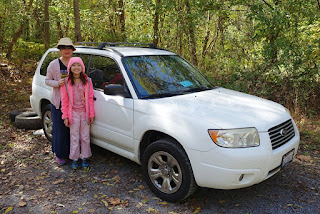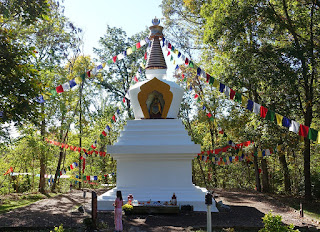If you read Yelp reviews, you may
have noticed the frequent use of the adjective “authentic” when people are
reviewing “ethnic” restaurants. But how exactly does one determine an
establishment’s “authenticity”? I assume it means the food tastes the same in
Falls Church, Virginia as it would at a similar restaurant in Taichung, Taiwan
- I was pondering this weighty question after my wife and I had dinner last
weekend at a Taiwanese café in Rockville, Maryland, an area known as “Little
Taipei” for its large Formosan expat community. But is that actually possible?
Based on my past experiences eating non-American cuisine in the U.S. and dining
on Western-style food overseas, it’s almost always the case that the taste of
the dishes has been altered, even in very subtle ways, to suit the local palate
(“Can I have the low-sodium soy sauce?”). Supposedly the fact that the cook is
from the mother country means the food he or she whips up is the “real deal”.
But the worst Japanese food I ever had was at a Japanese restaurant in Taichung
operated by a Japanese man who did all the cooking. My wife has eaten at
Chinese restaurants here in the States run by Taiwanese compatriots, chatting
amicably with the owners about the “old country”, only to tell me afterward
that the she didn’t like the dishes they served and therefore didn’t want to
eat there again. It’s apparent many of the foodies passing judgement on Yelp
and other websites haven’t spent much time in the countries of origin of the
food they’re praising online as being “authentic”; for others, the fact that
their ancestors came from the same countries as the cooks somehow qualifies them to
determine that all-important “authenticity” criterion.
Which brings me to another point: in some of the Yelp reviews, the presence of Asian
diners somehow lent an establishment more of that much-desired “authenticity”,
as in “The large number of Asians when I was there was a good sign”. But why
would that be such an auspicious omen? In the case of the Taiwanese restaurant
in Rockville, reviewers obviously assumed said diners were all
Chinese/Taiwanese. But were they? How many of them were Americans of Asian descent?
How many were from other Asian countries? Were they there because the food was
good? Or were they there because they were friends or relations of the owners? When
I was living in Taiwan, I would sometimes eat at Western-style restaurants not
for the “authentic” dishes (which they weren’t), but because they provided a
comforting degree of familiarity in a strange land. Might not some of the “Asian”
diners in the Taiwanese Rockville establishment be doing the same? Some of them
could have been foreign students, or expat businesspeople, or tourists, or
green card holders; strangers in an unfamiliar country seeking out something understandable,
even if the food could never taste as good as it is back home.
Which brings me back to the question
of “authenticity”: does the presence of, say, a Korean national in a Taiwanese
restaurant mean the food is better, much more akin to what you would find in
Taipei than you would in a Washington, D.C. suburb? Does seeing a
Taiwanese-American eating an oyster omelet in the same establishment make
everything more “authentic”, even though I’ve probably spent a lot more time
(and eaten out) in the land of their ancestors than they ever have? Does it
really matter if a lot of an Asian restaurant’s customers are of a similar
ethnic persuasion? In the end, the only considerations should be whether or not
the food is tasty, and is providing good value in relation to the prices being
charged. Forget about “authenticity”. If it’s “the real deal” a foodie is
after, the foodie should travel to the mother country and go restaurant-hopping
there – and it may be the case that too much authenticity might be more than
they could handle. And forget about the ethnic make-up of fellow diners – they’re
not necessarily in a better position to judge the quality of the food on offer.
Speaking of food, tonight we had dinner at all-American diner where all the employees were from Latin America. It came at the end of a day spent outdoors, our first as a family since our return to the Washington, D.C. area from the west coast. The northern Virginia/southern Maryland area is blessed with an abundance of parks offering walking trails - for today's outing, we drove to the McKee-Beshers Wildlife Management Area in Poolesville, Maryland. Driving on Maryland 190 and passing some huge mansions along the way (some looking like Southern plantations), we soon arrived at the parking lot:
The trail down to the Potomac River alternated between crop fields and woods. The sounds of hunters' guns in the distance kept my wife, not used to these things, on edge:
A solitary cherry tree maintains a vigil at the edge of a corn field:
The trail eventually came to the Potomac:
We walked along the elevated walkway that once served as the towpath trail for the Chesapeake & Ohio Canal. To the left of us in the photo below is the depression that remains from the C&O canal bed; the river is on the right:
We walked on for a while until we came to a group of people all wearing orange vests, not a good sign in area where hunting is allowed without need of permits. The people we saw were conducting field tests with their dogs, using blanks; on the other side of the road were hunters with live ammo. Not wanting to walk in dark clothing through woods crawling with armed men and women, we decided to backtrack, and returned to the Potomac:
Walking back and passing fields of soybeans:
The girls on the way back to the car, talking about weighty matters:
I'm receiving mixed signals here:
After 3 or so hours of walking, we returned to the car and drove to the nearby Kunzang Palyul Choling Buddhist temple:
Tibetan prayer flags:
The main temple building is housed in a charming old home, far removed from any Buddhist temple ever seen in Taiwan:
Inside is a prayer room and a small library:
Across River Road is the temple-owned Peace Park, containing another stupa:
Offerings included an Incredible Hulk Pez dispenser. The road to Nirvana takes many forms:
Down the road from the temple and heading back toward Washington is the historic 19th-century Seneca Schoolhouse. It serves as a "living history" field trip for visiting school kids. Unfortunately for us it's only open on Sundays and for private parties, meaning we could only look at the building from the front gate:
The Saints Peter and Paul Antiochian Orthodox Christian Church is further down River Road from the one-room schoolhouse. The church and the Romanian Food Festival going on nearby were an indication of the diverse makeup of this part of Maryland:
Back in Falls Church, and after dinner Amber tries her first pinball machine:


















No comments:
Post a Comment